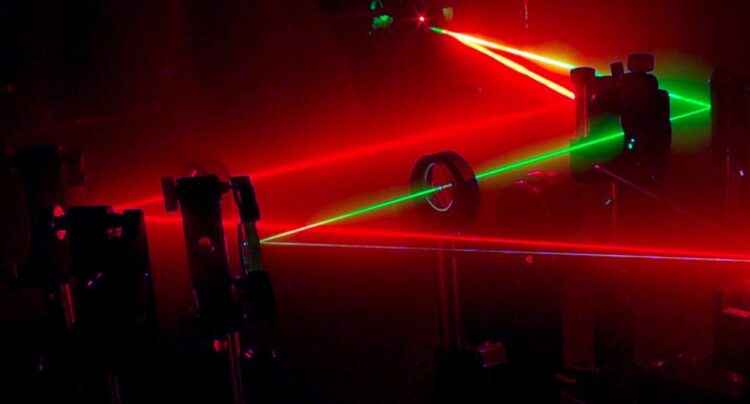The first lab-created “quantum abacus”

St Sndrews university laboratory
Credit: St Andrews University
A new study reports the first experimental creation of a quantum potential with energies given by sequences of prime numbers, paving the way for a new approach to the investigation of mathematical problems related to number theory using quantum physics.
Do you want to know whether a very large integer is a prime number or not? Or if it is a ‘lucky number’? A new study by SISSA, carried out in collaboration with the University of Trieste and the University of Saint Andrews, suggests an innovative method that could help answer such questions through physics, using some sort of ‘quantum abacus’.
By combining theoretical and experimental work, scientists were able to reproduce a quantum potential with energy levels corresponding to the first 15 prime numbers and the first 10 lucky numbers using holographic laser techniques. This result, published in PNAS Nexus, opens the door to obtaining potentials with finite sequences of integers as arbitrary quantum energies, and to addressing mathematical questions related to number theory with quantum mechanical experiments.
“Every physical system is characterized by a certain set of energy levels, which basically make up its ID,” explains Giuseppe Mussardo, theoretical physicist at SISSA – International School for Advanced Studies. “In this work, we have reversed this line of reasoning: is it possible – starting from an arithmetic sequence, for example that of prime numbers – to obtain a quantum system with those very numbers as energy levels?”
The answer is yes, as shown by the study published in PNAS Nexus. The researchers applied a system of differential equations to calculate the potential appearing in the Schrödinger equation of a quantum system, whose energy states correspond to a finite sequence of integers, extracted from a specific series, such as prime numbers or the close lucky numbers. Using sophisticated holographic experimental techniques, they were then able to create light traps with intensity profiles corresponding to the theoretically-defined potential.
“So far, we have calculated and created in the laboratory the quantum potential based on the first 15 prime numbers and the first 10 lucky numbers”, added Giuseppe Mussardo, “but the same approach could be applied, in principle, to other – even infinitely long – number sequences, as long as the numbers don’t grow too fast. More precisely, the growth of the infinite sequence needs to be less than N squared.”
The experimental part of the work required the use of complex holographic techniques and was performed by Donatella Cassettari’s team at the University of Saint Andrews. “The realization of these quantum potentials is a stringent test of the holographic techniques that have recently been developed by my team,” said the researcher. “This study shows that complex intensity profiles can be realized with good accuracy. Many interesting directions can be taken based on these results, for example potentials with a greater number of energy levels. In the future, testing the limit of these techniques will also be interesting.”
“Our work shows the feasibility of this method and paves the way for the exploration of genuine mathematical issues and arithmetical manipulations through quantum mechanics experiments: a kind of ‘quantum abacus’,” notes Andrea Trombettoni, physicist at the University of Trieste. “The method used and its possible generalizations may also lead to new applications in the field of quantum technology, which is currently the focus of much work and interest. Indeed, it provides a possible basic ingredient for a new class of devices, in which new algorithms that are relevant to quantum technologies – particularly quantum computing – can be designed and tested,” concluded the researcher.
Journal: PNAS Nexus
DOI: 10.1093/pnasnexus/pgac279
Method of Research: Experimental study
Subject of Research: Not applicable
Article Title: Holographic realization of the prime number quantum potential
Article Publication Date: 12-Dec-2022
Media Contact
Francesca de Ruvo
Scuola Internazionale Superiore di Studi Avanzati
fderuvo@sissa.it
Cell: 3297453567
Original Source
https://academic.oup.com/pnasnexus/article/2/1/pgac279/6888012
All latest news from the category: Physics and Astronomy
This area deals with the fundamental laws and building blocks of nature and how they interact, the properties and the behavior of matter, and research into space and time and their structures.
innovations-report provides in-depth reports and articles on subjects such as astrophysics, laser technologies, nuclear, quantum, particle and solid-state physics, nanotechnologies, planetary research and findings (Mars, Venus) and developments related to the Hubble Telescope.
Newest articles

NASA: Mystery of life’s handedness deepens
The mystery of why life uses molecules with specific orientations has deepened with a NASA-funded discovery that RNA — a key molecule thought to have potentially held the instructions for…

What are the effects of historic lithium mining on water quality?
Study reveals low levels of common contaminants but high levels of other elements in waters associated with an abandoned lithium mine. Lithium ore and mining waste from a historic lithium…

Quantum-inspired design boosts efficiency of heat-to-electricity conversion
Rice engineers take unconventional route to improving thermophotovoltaic systems. Researchers at Rice University have found a new way to improve a key element of thermophotovoltaic (TPV) systems, which convert heat…



